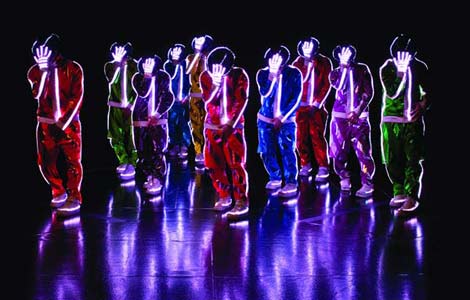Dance becomes popular stress relief
Updated: 2013-06-28 08:05
By Xu Jingxi in Guangzhou (China Daily)
|
||||||||
|
Wang Yuchi (right), a dance therapist in Guangzhou, shows participants at her workshop how to relax with the help of the special finger dance. Zou Zhongpin / China Daily |
In the Oscar-winning movie Silver Linings Playbook, Pat, a monomaniac who refuses to face the breakup with his ex-wife, and Tiffany, a widow whose life is a mess after her husband's death, heal their wounds by preparing for a dancing competition together.
They forget their troubles when they focus on practicing the jumps and lifts. They build up trust and love for each other with silent touches rather than flashy words.
Dancing turns out to be a miracle drug for the two mentally ill people.
And it also has become a trendy antidote to stress among young Chinese, especially urban female white-collar workers, in the past three years.
After a day of exhausting work, they go to "dance therapy" studios, which are usually in or near their cities' central business districts and thus not far from their offices; take off their high heels; and put on sportswear to learn about their own bodies so as to release the emotions locked in the shells.
Wang Yuchi is the first dance therapist in Guangzhou, capital of Guangdong province, and has been offering the service at the Sun Flower Counseling Center since 2010.
She has given dance therapy courses to about 50 people, each 10-week course carried out among a group of only five or six people.
A weekly class begins with participants relaxing their bodies by doing whatever movements they want to do. They are asked to put aside rational thinking and to just follow what they feel.
Then Wang will guide participants to observe and imitate each other's movements and share what they guess their teammates are feeling. "Remarks from others can help a self-restrained person to crack open the body to feel the emotions inside," Wang said.
Only when trust is built within a group will Wang start individual case studies. During a case study, the therapist designs movements for a particular participant to follow based on previous in-depth personal interviews in order to put the person in a situation similar to the one where he or she got the emotional scar.
The other members in the group surround their teammate to offer a sense of security, holding the person's hand when he or she gets too emotional and thus shakes and tumbles. They also listen to the person baring the old wound.
"The team's support is vital for dance therapy's effect," Wang said. "I shut down newcomers outside a group. Otherwise it will harm the trust within the group. And I will suspend the class if any member is absent."
Effective therapy
Wang said dance therapy is more than stress relief. It can help bridge people's physical movement and mental activity to root out the source of emotional problems. It is also an effective adjunctive therapy for mental illnesses.
Tony Zhou, co-founder and CEO of Inspirees Institute of Creative Arts Therapy which offers training programs to professionals in China to help them become dance therapists, points out some common misunderstandings about dance therapy.
"Some people think that only professional dancers are able to do the course. But dance therapy is not dancing performance. It doesn't require participants to strike a ballet pose. How you move your body is up to you. Self-expression is what matters," Zhou said.
On the contrary, some people take dance therapy superficially for the purpose of physical relaxation similar to yoga.
"What makes dance therapy special is its combination of art and science. Besides modern dance, it also involves psychotherapy and Laban Movement Analysis," said Zhou, a member of an international advisory board for the UK journal Body, Movement and Dance in Psychotherapy. LMA is a method and language for describing, visualizing, interpreting and documenting all varieties of human movement.
"Dance therapy cures people's emotional problems by bridging their physical movement and mental activity. The inconsistency of the two is the cause of emotional problems."
Dance therapist Wang further explains this kind of creative arts therapy with a metaphor: If a person is a tree, then his brain is the crown, reaching out all the time for sunlight and raindrops that can nurture the tree's growth. The roots are the person's emotions closely related to his inner self. What is between the crown and the root is the trunk - the person's body.
"A tree won't survive if the trunk, the passageway through which the crown and the roots exchange the nutrition they've got, is blocked. Dance therapy aims at relaxing the excessive restrictions on a person's body to connect his rational thinking and emotional feeling," Wang said.
She added that dance therapy also aims at clearing the "rotted roots", referring to the old wounds that the person ignores.
A health challenge
Chinese people's keen interest in dance therapy is also shown in the upsurge of workshops across the country where experts from the US and Europe are invited to teach local dance-therapists-to-be the theories and skills. For example, IICAT scheduled four such workshops and training courses in Beijing, Shanghai and Hong Kong from April 25 to June 16.
Faced with fast economic growth and social transitions, many Chinese are exhausted keeping up with hectic urban life or feel lost in handling the social changes. Therefore, mental problems are becoming a common health challenge in the country nowadays.
"China lacks a well-developed psychotherapy system, so people don't have many options for therapy. They will try on various ways to reduce their pressure, such as yoga and medication. When dance therapy appeared as a new option, they were quickly attracted," Zhou said.
Those pioneers who are promoting dance therapy in China are optimistic about its prospects in the country.
Hu Shenzhi, founder of Sun Flower Counseling Center, offered Wang the opportunity to carry out dance therapy at his center in 2010 because Hu believed it is a tradition in Chinese culture for people to achieve physical and mental health through moving their body.
"The tradition can be seen in tai chi and wuqinxi, a physical exercise that imitates the movements of five animals and is said to be created by noted physician Hua Tuo nearly 2,000 years ago. But at that time, people didn't realize the connection between body movement and mental activity yet," Hu said.
Zhou from IICAT points out that dance therapy, if carried out in groups, fits in with Chinese people's need to blend into society.
"Chinese society is suffering a credibility crisis, with people mentally isolating themselves and lacking a sense of belonging," Zhou said.
"Divided into groups to undergo dance therapy, patients can learn how to blend into society through learning to blend into the small groups first."
The advocate of dance therapy hopes people can see its potential of being applied in a wider range of social groups besides stressed urban white-collars.
"For those who have difficulty in verbal communication, for example, autistic children and senile old people, dancing is a better way of self-expression than struggling for words and sentences," Zhou said.
xujingxi@chinadaily.com.cn
(China Daily USA 06/28/2013 page5)

 Visit aids 'trust-building process'
Visit aids 'trust-building process'
 King of Pop returns
King of Pop returns
 Crowds cheer Court decision on gay marriage
Crowds cheer Court decision on gay marriage
 Hiring index signals further job weakness
Hiring index signals further job weakness
 Dance becomes popular stress relief
Dance becomes popular stress relief
 Philippine, US start Naval exercise in S China Sea
Philippine, US start Naval exercise in S China Sea
 Supreme Court gay rights ruling celebrated across US
Supreme Court gay rights ruling celebrated across US
 Rudd returns as Australian PM after Gillard
Rudd returns as Australian PM after Gillard
Most Viewed
Editor's Picks

|

|

|

|

|

|
Today's Top News
Senate OKs immigration reform; hurdles remain
Snowden could request asylum in Russia: official
US collects Internet data on citizens
Boston bombing suspect accused in 4 deaths
816 elected in provincial leadership reshuffle
US adds to DPRK sanctions list
Chinese pros put trust in blogs
More Americans see Snowden as patriot: Poll
US Weekly

|

|







